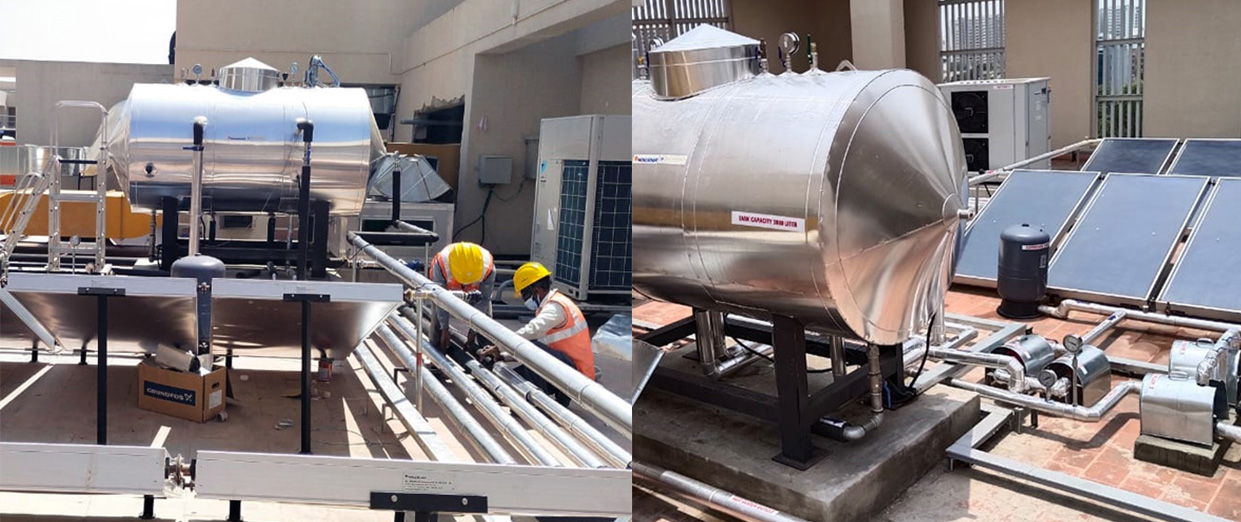+91 80883 54236
Novasolar that produces and sells solar water heaters.
In the quest for achieving carbon neutrality, high temperature heat pumps have become one of the key components for the industrial sector, representing a feasible alternative technology that enhances efficiency and minimizes fossil fuel burning.
In fact, the use of high temperature heat pumps and the transition for this model is supported by public projects across the globe, including a EU-funded project that is analyzing the possibility for supplying industrial processes in lower temperature ranges, as well as the incorporation of renewable sources (such as solar, industrial waste heat or seawater heat, among others).
Keep reading to find out about what high temperature heat pumps are, their potential for decarbonizing the industry, and what industry operators can do to access the right equipment.
High temperature heat pumps are designed to operate at higher temperature differentials than conventional heat pumps. As such, they fit within the definition of a conventional heat pump (a device that transfers heat from one place to another, typically from a lower temperature to a higher temperature), but just with different temperature differentials.
This means that heat pumps typically operate at temperatures between 80°C and 85°C, and can achieve COPs (coefficient of performance) of up to2.5-3.5, depending on the heat source temperature. That is, for every unit of electricity consumed, well-adjusted high temperature heat pumps can produce up to 5 units of heat. All in all, this type of heat pump is able to upgrade low temperature heat sources (such as industrial waste heat).
High temperature heat pumps are used in applications where heat is required at a high temperature. These include industrial processes, but also space heating, and hot water production, also as part of district heating projects.
High temperature heat pumps are based on the following basic principle: they’re able to transfer heat from a lower temperature system to a higher temperature one. In order to do so, a refrigeration cycle takes place.
The main components of high temperature heat pumps include:
Evaporator: in charge of absorbing heat from the source (such as air, seawater, or the ground) and converting it into a low pressure, low temperature vapor.
Compressor: takes low pressure, low temperature vapor and compresses it, with the result of increasing its temperature and pressure.
Condenser: the high pressure, high temperature vapor flows into the condenser, which turns it back into liquid as vapor releases heat.
Expansion valve: reduces the pressure of the liquid, causing it to evaporate and start the cycle anew.
Additionally, high temperature heat pumps use other advanced technologies such as oil free, magnetic bearing centrifugal compressor or oil flooded high pressure screw compressors, heat exchangers and refrigerants, all able to withstand high critical temperatures to achieve high pressure differentials.
High temperature industrial heat pumps have been hailed as one of the key technologies that will be able to decarbonize a number of industrial processes as part of numerous heat pump applications in the industry.
This potential has been measured by research papers using techno-economic bottom-up cost optimization models, ensuring the system remains sustainable in both environmental and economic terms.
Some of the benefits of high temperature industrial heat pumps are:
Increased efficiency: able to deliver up to four units of heat for every unit of energy consumed Integration of renewable energies: thanks to their capacity for upgrading low-grade energy, high temperature heat pumps can integrate renewable energy sources such as solar, geothermal or waste heat. As such, they provide a pathway towards industrial decarbonization Low maintenance: as they present fewer moving parts, they’re more reliable and easier to maintain

|
Product model |
NSHP-15H |
NSHP-30H |
NSHP-48H |
NSHP-68H |
|
Cabinet |
Galvanized steel with epoxy painting |
|||
|
Compressor |
Copeland/Invotech High Temp Scroll Compressor |
|||
|
Refrigerant |
Honeywell R1234YF or Dupont R134a |
|||
|
Power supply |
380-415V/3Ph/50Hz |
|||
|
Condenser |
High efficient tube in tube heat exchanger |
|||
|
Expansion valve |
SANHUA EEV/ thermostatic |
|||
|
AC contactor |
Schneider/Abb |
Schneider/Abb |
Schneider/Abb |
Schneider/Abb |
|
Heating capacity (kW) |
15 |
30 |
48 |
68 |
|
Heating capacity (Kcal/hr) |
12898 |
25795 |
41280 |
58469 |
|
Input power (kW) |
4.95 |
9.95 |
19 |
23 |
|
Rated current (A) |
9.88 |
29 |
16 |
45 |
|
COP (Coefficient of Performance) |
3 |
3 |
3 |
3 |
|
Production capacity (L/H) |
215 |
430 |
950 |
1300 |
|
Max input power (kW) |
9 |
17.5 |
19 |
41 |
|
Max input current (A) |
15.8 |
39 |
45 |
58 |
|
Rated outlet water temperature (℃) |
70 |
|||
|
Max outlet water temperature (℃) |
75 |
|||
|
Working temperature condition (℃) |
5--45 |
|||
|
IP Grade (Level of protection) |
IPX4 |
|||
|
Anti-electric shock Rate |
I |
|||
|
Noise 1 m (dB(A)) |
≤56 |
≤62 |
≤62 |
≤70 |
|
Net weight/Gross weight(kg) |
156/172 |
293/315 |
293/315 |
690/735 |
|
Diameter of pipe (mm) |
DN40 |
DN40 |
DN40 |
DN50 |





